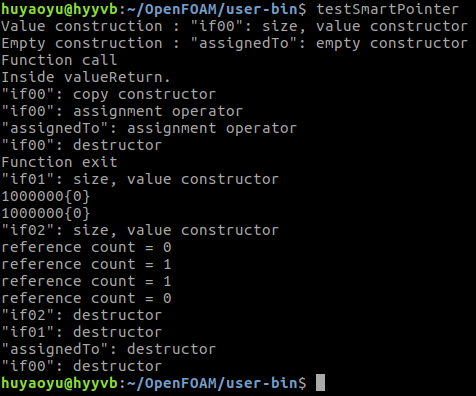OpenFOAM: The autoPtr and tmp smart pointers
Introduction
I was learning to program with OpenFOAM these days. This post is my notes on the smart pointers of OpenFOAM. The source code is originally created by Tomislav Maric, Jens Hoepken, and Kyle Mooney. You can find their emails in the source code. I made some changes in order to show more information that concerns me.
OpenFOAM provides two types of “smart pointer”. They are autoPtr and tmp. Before I learned these smart pointers, I was thinking that they will work like the smart pointer in boost. It turns out that I was wrong.
After digging into the source code, I got a new understanding of autoPtr and tmp.
autoPtr
It seems that autoPtr is designed to be used when you want a temporary object, which is created by the new operation, that gets destroyed automatically when the program goes out of a certain scope. It does NOT have a reference counter and is different from the smart pointer in boost. autoPtr has such a unique behavior that when you assign the value of one autoPtr to another or create a new autoPtr by the copy construction function, the reference to the actual raw pointer in the original autoPtr is released. That is to say, the ownership of the raw c++ pointer is transferred between autoPtrs.
To be honest I was not able to figure out why we have to design autoPtr like this. After searching on Google, it seems that autoPtr is for the purpose of dynamics data manipulation. I have not yet got that far with OpenFOAM.
tmp
tmp is more interesting. tmp provides the function of reference count by the refCount class. However, you can only raise the number of reference to a raw C++ pointer up to 2. The following commented codes will cause an exception raised by OpenFOAM when the user is attempting to refer to a raw pointer for the third time.
// Showing reference counts.
tmp<infoScalarField> t1(new infoScalarField(1e06, 0, "if02"));
Info << "reference count = " << t1->count() << endl;
{
tmp<infoScalarField> t2 (t1);
Info << "reference count = " << t1->count() << endl;
{
// This will cause an exception since tmp doesn't allow
// reusing an object for more than two times.
// tmp<infoScalarField> t3(t2);
// Info << "reference count = " << t1->count() << endl;
} // t3 destructor called
Info << "reference count = " << t1->count() << endl;
} // t2 destructor called
Info << "reference count = " << t1->count() << endl; I was totally confused when I was studying the source code of tmp. Then I found a good explanation on OpenFOAM Wiki. tmp is designed for handling a large amount of memory between function calls. That is, you could use tmp to pass objects to a function as an argument, or get the return value from a function, with the object holding a large amount of memory. During the above operation, no significant memory copy occurs. And you do not need more than two references to a raw C++ pointer when invoking a function or returning from a function.
OpenFOAM Wiki lists a sample code to illustrate the usage of tmp. I just copy it here.
// Original:
largeClass myFunc ()
{
largeClass returnMe(new largeClass);
// Somehow fill the data in returnMe
return returnMe;
}
// Becomes:
tmp<largeClass> myFunc()
{
tmp<largeClass> tReturnMe(new largeClass);
largeClass& returnMe = tReturnMe();
// Somehow fill the data in returnMe
return tReturnMe;
}Other C++ stuff
My C++ knowledge still needs improvements. When studying the code provided by Tomislav Maric, et al. I learned that the copy constructor, not the assignment operator (=), will be called when an object is created at initialization. To be specific, I was talking about the line of Type temp = t; in the following code.
// The argument t doesn't require a copy operation since it is
// a reference to a const Type object.
template<typename Type>
Type valueReturn(Type const & t)
{
Info << "Inside valueReturn." << endl;
// One copy construction for the temporary.
Type temp = t;
// One explicit assignment.
temp = t;
// ... operations (e.g. interpolation) on the temporary variable.
return temp;
}Acknowledgment
The cover image of this post is copied from the website of OpenFOAM. And I modified the words on the original image. The image may be the property of The OpenFOAM Foundation.
The source code
The source code could be found on my github repo. And the output is like this.
